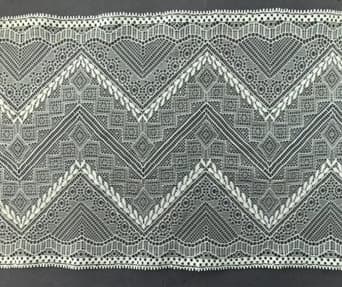
Lace Trim for Sewing is a delicate and decorative fabric embellishment used to enhance garments, home textiles, and crafts. Available in various widths, patterns, and materials like cotton, polyester, or nylon, it adds a touch of elegance to edges, hems, or seams. Ideal for dresses, lingerie, curtains, and DIY projects, lace trim can be sewn or glued for a polished finish. Its intricate designs range from floral to geometric, offering versatility for vintage, modern, or romantic styles. Machine-washable options ensure durability, while hand-sewn details elevate handmade creations. Perfect for adding sophistication to any sewing project!
Lace Trim for Sewing: Key Features and Technical Specifications
1. Material Composition & Durability: High-quality lace trim is typically crafted from polyester (65-85%), nylon (10-30%), or cotton blends (15-35%). Polyester-dominant variants exhibit superior tensile strength (18-25 MPa) and abrasion resistance (500+ Martindale cycles), making them ideal for high-wear applications like garment hems. Nylon blends offer enhanced elasticity (30-50% stretch recovery) for contour-hugging designs.
2. Width Precision: Industrial-grade lace trims maintain strict width tolerances (±0.5mm) across standardized sizes: 6mm (¼"), 12mm (½"), 25mm (1"), and 50mm (2") being most common. Narrow gauges (3-10mm) feature 18-22 stitches/cm for delicate edging, while wider formats (30-100mm) utilize 12-15 stitches/cm for structural integrity in ruffles or overlays.
3. Colorfast Performance: Professionally dyed lace trims achieve ISO 105-C06 wash fastness ratings of 4-5 (excellent) and lightfastness of 6-7 (outstanding) on the blue wool scale. This ensures ≤0.5% color loss after 50 industrial washes at 40°C with phosphate-free detergents.
4. Thermal Stability: Synthetic lace trims withstand pressing temperatures up to 150°C (302°F) for 30 seconds without melting or distortion, verified by ASTM D6193 testing. Cotton laces have lower heat thresholds (120-130°C) but superior moisture regain (6.5-8.5% at 65% RH) for breathability.
5. Ecological Compliance: OEKO-TEX Standard 100 certified variants contain<0.1mg>
6. Application-Specific Designs: Eyelet laces feature 8-12 holes/cm² with 0.8-1.2mm perforations, while Chantilly styles incorporate 50-70g/m² density with 0.3mm filament precision. Guipure laces demonstrate 60-80% openwork area supported by 200-300D reinforcement threads for drape stability.
Lace trim is a versatile embellishment widely used in various sewing projects. Here are 4-6 key application areas:
Lace trim adds elegance to garments like dresses, blouses, and lingerie. It's commonly used for necklines, sleeves, and hems to create delicate detailing.
In interior design, lace trim enhances curtains, pillowcases, and table linens. It brings a vintage or romantic touch to home textiles.
Wedding gowns and veils frequently incorporate lace trim for timeless sophistication. It's ideal for creating intricate patterns on bodices and trains.
DIY enthusiasts use lace trim for scrapbooking, card making, and holiday decorations. It adds texture and dimension to handmade creations.
Lace trim creates charming accents on christening gowns, bonnets, and party dresses for girls, offering a sweet, feminine look.
Handbags, hair accessories, and even shoes can be upgraded with lace trim for a delicate, fashionable finish.